When God first made himself known to me it was like a swift kick where I needed it. Later when out of the blue the Lord Jesus showed me he loved me, it was sweet and gentle, and ever since I have loved him back with all my heart. Someday maybe I’ll tell you those stories. Maybe not. The point is that God works with us in different ways.
Likewise with his saints. If you’ve been reading this Blog, you know how Nicholas and Nektarios just “took hold of me” in a wonderful way.
At other times certain saints may quietly, inexplicably draw us to themselves. Here are 3 such saints from my life.
Saint David of Thessaloniki, the Dendrite
… meaning “tree dweller”, from the Greek “dendron, δένδρον”.
Why I should love this strange man I have no idea. I’m afraid of heights. Living in a tree is the last thing I’d ever want to do. Nevertheless, from the first time I met him he won me over.
David apparently was from Mesopotamia, then a great monastic center. How or why he came to Thessaloniki we don’t know, but there outside the city he climbed into an almond tree, probably inspired by the Middle Eastern stylites. When people asked why in the world he was up there, he said God had told him to, and he would come down when God told him to come down. The story says he set up a bench on a sturdy limb. Because Thessaloniki is cold in the winter, and also for practical reasons, I’d guess his dwelling was somewhat more elaborate than that. Like the Stylites, David attracted much attention – became something of a tourist attraction, one might say. When after 3 years God told him to come down, the Archbishop and many others were there to welcome him.
Now he moved into a little cell below where more strange things happened. Quoting from John Moschos’ The Spiritual Meadow: “At this time, because of the barbarians, the walls of the city were patrolled at night by soldiers. One night those who were on guard-duty…saw fire pouring from the windows of the recluse’s cell. The soldiers thought the barbarians must have set the elder’s cell on fire; but when they went out in the morning, to their amazement, they found the elder unharmed and his cell unburned. Again the following night they saw fire…in the elder’s cell—and this went on for a long time. The occurrence became known to all the city and the countryside. Many people would come and keep vigil at the wall all night long in order to see the fire… I said to myself: ‘If God so glorifies his servants in this world, how much more so in the world to come when He shines upon their face like the sun?”(pp. 52-3) You may remember how one of the Desert Fathers of Egypt said to a disciple, “If you wish, you can become all fire”, and as he prayed, hands uplifted, flames went up from his fingers.
David was persuaded to visit Constantinople where he met the Empress Theodora, then went into the Senate and censed them all (Do you think this might help our U.S. Senate?), holding charcoal and incense in his hands without being burned. David the Dendrite died on the way home at about age 90, on June 26, 540. His relics were kept at a little monastery which had grown up around him, till in the 14th century the Latins stole him. Through the efforts of the Metropolitan of Thessaloniki, they 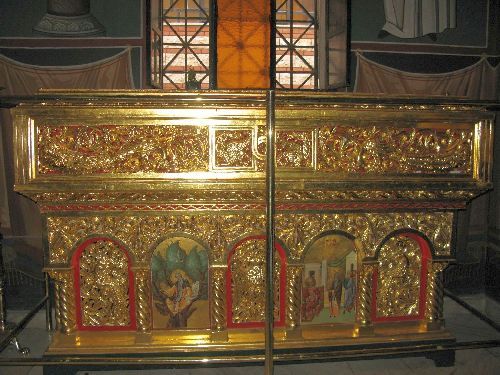 were finally returned in 1978 and now lie in the lovely
were finally returned in 1978 and now lie in the lovely 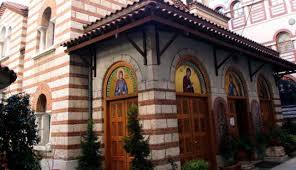 little monastery church of Agia Theodora near the waterfront in downtown Thessaloniki. When I was first there many years ago I knew nothing of Saint David. I stayed till they chased me out at closing time. I could not bring myself to leave. I didn’t know why. Now I think I know why.
little monastery church of Agia Theodora near the waterfront in downtown Thessaloniki. When I was first there many years ago I knew nothing of Saint David. I stayed till they chased me out at closing time. I could not bring myself to leave. I didn’t know why. Now I think I know why.
Saint Martin the Merciful of Tours
Martin came from Pannonia (modern Hungary), born in 316 (336?) soon after the Great Persecution had ended. His father, an officer in the imperial army, was pagan, but during his boyhood Martin became a catechumen of the Church. He felt obliged to follow his father into the army – though he was uneasy about it, since he felt it was wrong for a Christian to kill another human being. Saint Martin the Merciful.
Martin was on duty at Amiens in Gaul, north of Paris, when he saw a beggar shivering in the winter cold, so he cut his cloak in two and gave half to the beggar. 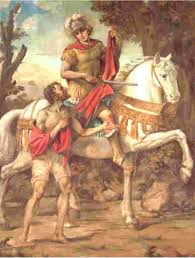 It is said that night Christ appeared to Martin, wearing the cloak he had given to the beggar. Soon after, Saint Martin the Merciful was baptized.
It is said that night Christ appeared to Martin, wearing the cloak he had given to the beggar. Soon after, Saint Martin the Merciful was baptized.
He reluctantly stayed in the army. 2 years later barbarians were invading Gaul and he knew he would have to kill in battle, so Martin asked for a discharge. When his commander accused him of cowardice, Martin volunteered to stand unarmed in the front line. But next day the barbarians surrendered without a fight, and Martin was allowed to leave.
For some time he traveled. It seems he lived alone for a while on an island off the Italian coast. Then he came to know Saint Hilary, Bishop of Poitiers, and spent time in his diocese as an ascetic. Already he was becoming known, and the people of Tours, on the River Loire in the west of France, called him to be their bishop. He did not want it. He hid from them, some say in a goose shed, but people from Tours found him and lured him out by a trick: One of them told him that a poor man needed help. Saint Martin the Merciful thought he must respond. When he emerged, they hauled him off and had him consecrated as their bishop!
In Tours Martin established an abbey at Marmoutier (here it is today), a few miles away on the Loire. He made this his residence, so he could retreat from the commotion of the city and live and pray as a monk. Martin was a good administrator and pastor: he set up a system of parishes and tried to visit them all annually. But he was known above all for his many works of charity. Saint Martin the Merciful.
Martin defended Orthodoxy against the Arians and fiercely opposed paganism. He destroyed a number of pagan temples. The historian Sulpicius Severus, who knew him personally and wrote his biography, recorded the time when Martin was about to fell a sacred tree, and druids dared him to stand in its way as it fell. He did, it missed him, they took it as a sign and were baptized.
At that time in the Diocese of Ossonoba in Portugal the Priscillians were a sort of Manichaean sect. Their bishop Ithacius, fed up with them, asked Emperor Magnus Maximus to destroy them. Martin, who opposed such violence, traveled to Trier where the Emperor was holding court and begged him to spare them. Saint Martin the Merciful.
Martin died on November 8, 397 (398?) while making a pastoral visit to the church in Candes, a town along the Loire. Legend has it that as his body was being carried home by boat the trees along the river burst into blossom. Perhaps it’s not a legend. In many places, before the pre-winter cold sets in, there is a week or two of calm almost summer-like weather. In America it’s called “Indian Summer”, in Greece the “Little Summer of Saint Demetrios” – and I read that in places in western Europe it is still called “Saint Martin’s Summer”.
Martin was buried on November 11, the usual day he is commemorated, though in some places it’s November 12. (The Russian date of October 12 seems to be a clerical error.) His burial place drew many pilgrims during the Middle Ages, and in the year 1008 (it took long enough!) a great cathedral was built for him in Tours. Many churches were named for him. (You classical music buffs have likely heard music from the “Academy of Saint Martin’s in the Fields” in London.) During the French revolution, the cathedral was destroyed, together with most of his relics . (Why do people do these things?) But a new cathedral has been built on the site to house the few fragments of his relics which have been recovered, and again there are many pilgrims.
My only contact with Saint Martin was a transitory one. On a misty, moisty morning, as our train sped through Tours hurrying towards Paris, I waved out the window to Saint Martin the Merciful.
Saint Bede the Venerable
On a cold rainy morning in July 1978, Khouria Dianna and I climbed from Durham city up the hill to Durham (Anglican) Cathedral – properly called “The Cathedral Church of Christ, Blessed Mary the Virgin and Saint Cuthbert of Durham”) – a bleak grey Norman structure that seemed to fit the weather. There we found the tomb of “The Venerable Bede” as he is usually titled – and properly pronounced “Beed”.
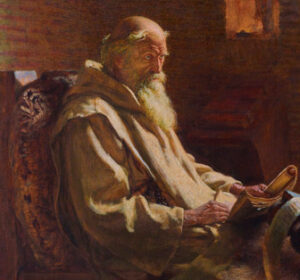
Bede was a gentle, holy, humble Benedictine monk who was the greatest of early English scholars. In a note added to one of his writings, Bede told that at age 7, in the year 794, he had come to the Benedictine Saint Peter’s Abbey at Jarrow, Wearmouth, near Durham. The lack of specifics about his background has caused many to think he was orphaned and went to the Abbot Benedict Biscop in desperation. It was said that afterwards whenever the monks chanted the Psalm verse “Though my father and mother forsake me, the Lord will receive me”, Bede would begin to cry in gratitude that he had found a home. Bede added that at age 19 he was made deacon, and priest when he was 30. During the rest of his life, except for a few brief travels, he never left the Abbey
Bede’s life consisted first of prayer, then of learning and writing.
Benedictine spirituality, derived directly from the monastic rules of Saint Basil the Great, was (and in most ways still is) remarkably similar to our classic Orthodox monastic style – the daily Offices, grounded in the Psalms. (“7 times a day will I praise thee.” Psalm 118/119) Go to any traditional Orthodox or Benedictine monastery today, and you’ll know what shaped Bede.
As for learning and writing, Bede’s abbot on his travels brought back so many books that Jarrow possessed between 300 and 500 of them, almost certainly the largest library in England at the time – and Bede made every use of them. Though he spoke Anglo-Saxon (pre-Chaucerian English), he was proficient in Latin, Greek and to some extent Hebrew. From his writings it is obvious that he had read the early Fathers extensively. He wrote numerous commentaries on the Holy Scriptures, often using allegorical interpretation as we Orthodox sometimes do. He wrote poetry, hymnody, about grammar and science (he mentioned that “the earth is round like a ball”) and more.
However, Bede’s classic ground-breaking work was his Ecclesiastical History sf the English People, without which almost nothing would be known for sure about early British Christian history. Like a modern historian he culled information from many sources both written and oral, old and new, being critical when it was appropriate. If you want evidence that early England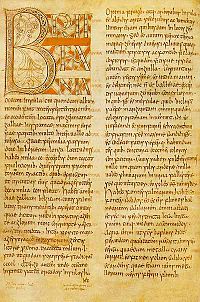 was geniunely Orthodox, read this book. It has the spirit and style and “feel” of Orthodoxy, from ancient times till today. A modern English source notes that he did not possess a modern skepticism about the supernatural. God!
was geniunely Orthodox, read this book. It has the spirit and style and “feel” of Orthodoxy, from ancient times till today. A modern English source notes that he did not possess a modern skepticism about the supernatural. God!
There was a dispute at the time between those who followed the earlier British (Celtic) forms of worship and Church organization (more like disorganization!) and the later (to Bede, “modern”) Roman ways which had been brought to England by the Papal mission to the Angles, led by Saint Augustine of Canterbury. Bede supported Rome – which in those days was still Orthodox, a far cry from the modern Papacy – likely because he thought the British Christians needed protection against new pagan intrusions. And he wrote the history of how the Synod of Whitby decided for Rome in 664.
But for all his intellectual capability, here is what Bede wrote about learning: “Better a stupid and unlettered brother who, working the good things he knows, merits life in Heaven, than one who though being distinguished for his learning in the Scriptures, or even holding the place of a doctor, lacks the bread of love.”
As Bede’s health failed, he was working on a translation of Saint John’s Gospel into Anglo-Saxon. He attended services as long as he could. After that, confined to his bed, he could hear them being sung,. He continued to dictate his translating to a young monk, but often faded in and out. Finally his scribe said to him, Father you have only a little way to go. Bede completed the last verses. The young monk said, “It is finished, father.” Bede replied, “Yes, truly it is finished”, said “Glory to the Father and to the Son and to the Holy Ghost”, and was gone.
The Venerable Bede died on the Eve of the Ascension, May 25, 735, but is commemorated on May 27, 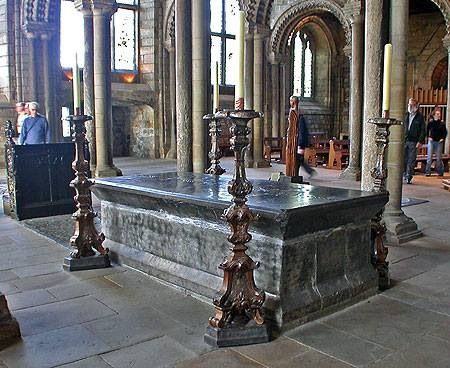 so as not to conflict with the May 26th feast of Saint Augustine. His body was first buried at the monastery church at Jarrow. In 1022 his relics were taken to Durham Cathedral, where they lie today in the Galilee chapel. How did he escape Henry VIII and the Reformation?
so as not to conflict with the May 26th feast of Saint Augustine. His body was first buried at the monastery church at Jarrow. In 1022 his relics were taken to Durham Cathedral, where they lie today in the Galilee chapel. How did he escape Henry VIII and the Reformation?
As with most saints in most Anglican churches the Venerable Bede is honored at Durham, but just barely. When we were there, I think maybe a candle was burning. There was nobody around. I thought he deserved more than that.
Saints!
Brothers and sisters, know the lives of God’s saints, these holy examples and guides and intercessors. You can read about them daily on the websites of almost any Orthodox Archdiocese.
Some of them, maybe even some of the peculiar ones, may reach out to you, and you will find new brothers or sisters on high to love.
Has this already happened to you? Please tell us about it.
Next 2 weeks: The Elevation of the Holy Cross and why the world doesn’t get it

Thank you for this wonderful article. A few years ago at one of your study groups at St. Nicholas, we were reading from a book about the lives of several contemporary holy elders, and there was a very brief chapter about then-Elder, now Saint Paisios the Athonite. I read only one paragraph about his life in class — a brief synopsis — and that night I dreamt about him. I have since been very drawn to him and have read many of his writings. I also feel very drawn to his contemporaries, in particular, Saint Porphyrios. Love the book about his life, Wounded By Love.
I loved this! Thank you for introducing these holy friends!
I also love St Paisios; I have met him through writings by and about him. Now his icon is on my kitchen wall reminding me not to yell at my kids 🙂
It seems like I do need to acquaint myself with St.Paisios. The yelling really does get to me, and I always feel horrible afterwards – wondering if I am demonstrating Christ-likeness to my kids.
St Paisios on family life is so reassuring… it’s good to be reminded over and over that the most important thing is prayer and that I can’t really control outcomes.
Thank you Father! The lives of Saints are so inspiring. The Saints do seem to “make my acquaintance”. Three Saints who have come to make me love them are St. Mary of Egypt, St. Andrew the Fool for Christ, and St. Christopher.